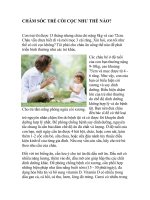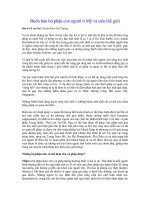Canada’s Aging Population: Seizing the Opportunity ppt
Bạn đang xem bản rút gọn của tài liệu. Xem và tải ngay bản đầy đủ của tài liệu tại đây (1.43 MB, 247 trang )
Special Senate
Committee on Aging
Final Report
Canada’s Aging Population:
Seizing the Opportunity
The Honourable Sharon Carstairs, P.C., Chair
The Honourable Wilbert Joseph Keon, Deputy Chair
April 2009
This report is dedicated to the seniors who have not had the
support they need as our society has tried to come to terms with
monumental societal shifts which have inadvertently shunted
them to the sidelines.
It is dedicated to seniors who have held onto the hope of a
better world in which to age.
It is dedicated to the seniors, advocates, caregivers, health care
workers, academics and other experts who have devoted their
lives and energies to bringing about this better world, who have
so generously shared their passion with this Committee.
For more information, please contact us
by e-mail:
by phone: (613) 990-0088
toll free: 1 800 267-7362
by mail: The Special Senate Committee on Aging
The Senate, Ottawa, Ontario, Canada, K1A 0A4
This report can be downloaded at:
www.senate-senat.ca/age.asp
Ce rapport est également offert en français
Special Senate Committee on Aging
Final Report
Canada’s Aging Population:
Seizing the Opportunity
The Honourable Sharon Carstairs, P.C., Chair
The Honourable Wilbert Joseph Keon, Deputy Chair
April 2009
This report is dedicated to the seniors who have not had the
support they need as our society has tried to come to terms with
monumental societal shifts which have inadvertently shunted them to
the sidelines. It is dedicated to seniors who have held onto the hope
of a better world in which to age. It is dedicated to the seniors,
advocates, caregivers, health care workers, academics and other
experts who have devoted their lives and energies to bringing about
this better world, who have so generously shared their passion with
this Committee.
For more information, please contact us
by e-mail:
by phone: (613) 990-0088
toll free: 1 800 267-7362
by mail: The Special Senate Committee on Aging
The Senate, Ottawa, Ontario, Canada, K1A 0A4
This report can be downloaded at:
www.senate-senat.ca/age.asp
Ce rapport est également disponible en français
TABLE OF CONTENTS
i
Canada's Aging Population: Seizing the Opportunity
Table of Contents
MEMBERSHIP V
ORDER OF REFERENCE VII
A MESSAGE FROM THE CHAIR IX
FOREWORD 1
A FEW WORDS ABOUT DEFINITIONS 2
SETTING THE VISION 5
WHAT THE COMMITTEE LEARNED 5
IMPLEMENTING THE COMMITTEE’S VISION 9
CHAPTER 1: COUNTERING AGEISM 11
1.1 DEFINING AGEISM 12
1.2 MOVING TOWARD A POSITIVE VIEW OF AGING 14
1.3 COMPETENCY 16
1.4 COMPETENCY AND DRIVING: NOT JUST A SENIORS
ISSUE 19
1.5 COMPETENCY AND WORK 22
1.6 ABUSE AND NEGLECT 24
CHAPTER 2: INTEGRATING CARE 33
2.1 A MOVE TO INTEGRATED CARE 34
2.2 CONTINUUM OF SERVICES AND CARE FOR AGING IN
THE
PLACE OF CHOICE 41
CHAPTER 3: COMPARABLE ACCESS TO SERVICES
ACROSS THE COUNTRY 63
3.1 SENIORS AND HEALTH CARE COSTS 63
3.2 HEALTH PROMOTION EFFORTS CAN HELP REDUCE
HEALTH CARE COSTS 65
3.3 DEMOGRAPHIC PROJECTIONS FOR PROVINCES AND
TERRITORIES 67
3.4 A SUPPLEMENTARY PROGRAM TO COMPENSATE FOR
UNEVEN AGING ACROSS THE PROVINCES AND
TERRITORIES 68
3.5 COMPARABLE ACCESS TO MEDICATIONS: A NATIONAL
FORMULARY 70
TABLE OF CONTENTS
ii
Canada’s Aging Population: Seizing the Opportunity
CHAPTER 4: ACTIVE AGING IN AGE-FRIENDLY
CITIES AND RURAL COMMUNITIES 73
4.1 ACTIVE AGING 73
4.2 AGE-FRIENDLY CITIES AND RURAL COMMUNITIES 83
4.3 UNIVERSAL DESIGN 86
4.4 TRANSPORTATION 88
CHAPTER 5: ELIMINATING POVERTY 93
5.1 PENSIONS 94
5.2 SAVINGS 98
5.3 OLD AGE SECURITY/GUARANTEED INCOME
SUPPLEMENT (OAS/GIS) 100
5.4 EARNINGS 106
5.5 THE INCOME SECURITY SYSTEM 111
CHAPTER 6: SUPPORTING CAREGIVERS 117
6.1 POLICY SUPPORTS TO HELP CAREGIVERS 119
6.2 A NATIONAL CAREGIVER STRATEGY 128
CHAPTER 7: SUPPORTING THE VOLUNTARY
SECTOR 131
7.1 SENIORS AND THE VOLUNTARY SECTOR 131
7.2 NEW HORIZONS FOR SENIORS PROGRAM 136
CHAPTER 8: THE HEALTH AND SOCIAL CARE
WORKFORCE 139
8.1 INCREASING THE SUPPLY OF TRAINED
GERONTOLOGISTS AND GERIATRICIANS 142
8.2 ADAPTING TRAINING FOR AN AGING POPULATION 147
8.3 TRAINING OF HOME CARE AND PERSONAL SUPPORT
WORKERS 149
CHAPTER 9: INCORPORATING RESEARCH AND
NEW TECHNOLOGY 155
9.1 RESEARCH ON AGING 155
9.2 TELEMEDICINE AND TELEHOMECARE 158
9.3 ELECTRONIC HEALTH RECORD 161
CHAPTER 10: FEDERAL POPULATION GROUPS –
LEADING BY EXAMPLE 165
10.1 DIRECT FEDERAL LEADERSHIP 165
10.2 VETERANS 165
10.3 FIRST NATIONS AND INUIT 171
TABLE OF CONTENTS
iii
Canada's Aging Population: Seizing the Opportunity
10.4
FEDERAL OFFENDERS 178
10.5 NATIONAL LEADERSHIP AND INDIRECT
RESPONSIBILITY 182
10.6 OFFICIAL LANGUAGE MINORITY SENIORS 182
10.7 ABORIGINAL SENIORS 187
10.8 THE GOVERNMENT OF CANADA MOVES FORWARD AS
LEADER 190
APPENDIX I: LIST OF RECOMMENDATIONS BY
FRAMEWORK 193
APPENDIX II: COMPLETE LIST OF
RECOMMENDATIONS 203
APPENDIX III: CHECKLIST OF ESSENTIAL
FEATURES OF AGE-FRIENDLY CITIES 211
APPENDIX IV: LIST OF WITNESSES SECOND
SESSION THIRTY-NINTH PARLIAMENT 215
APPENDIX V: COSTS: COMMUNITY VERSUS
FACILITY 233
MEMBERSHIP
v
Canada's Aging Population: Seizing the Opportunity
Membership
The Honourable Sharon Carstairs, P.C., Chair
The Honourable Wilbert Joseph Keon, Deputy Chair
And
The Honourable Senators:
Maria Chaput
Anne C. Cools
Jane Cordy
Terry M. Mercer
Terry Stratton
Ex-officio members of the Committee:
The Honourable James Cowan, (or Claudette Tardif) and Marjory
LeBreton, P.C., (or Gérald Comeau)
Analysts from the Parliamentary Information and Research Service of
the Library of Parliament:
Julie Cool
Havi Echenberg
Nancy Miller Chenier
Michael Toye
Karin Phillips
Senate Committees Directorate:
Keli Hogan, Clerk of the Committee
Monique Régimbald, Administrative Assistant
Research Staff:
Michelle MacDonald, Special Advisor to the Committee
ORDER OF REFERENCE
vii
Canada's Aging Population: Seizing the Opportunity
Order of Reference
Extract from the Journals of the Senate of Tuesday, February 10,
2009:
Resuming debate on the motion of the Honourable Senator
Carstairs, P.C., seconded by the Honourable Senator Hubley:
That a Special Committee of the Senate be appointed to examine
and report upon the implications of an aging society in Canada;
That, notwithstanding rule 85(1)(b), the committee be comprised of
seven members, namely the Honourable Senators Carstairs, P.C.,
Chaput, Cools, Cordy, Keon, Mercer, and Stratton, and that three
members constitute a quorum;
That the committee examine the issue of aging in our society in
relation to, but not limited to:
• promoting active living and well being;
• housing and transportation needs;
• financial security and retirement;
• abuse and neglect;
• health promotion and prevention; and
• health care needs, including chronic diseases, medication use,
mental health, palliative care, home care and caregiving;
That the committee review public programs and services for
seniors, the gaps that exist in meeting the needs of seniors, and the
implications for future service delivery as the population ages;
That the committee review strategies on aging implemented in
other countries;
That the committee review Canada's role and obligations in light of
the 2002 Madrid International Plan of Action on Ageing;
That the committee consider the appropriate role of the federal
government in helping Canadians age well;
ORDER OF REFERENCE
viii
Canada’s Aging Population: Seizing the Opportunity
That the committee have power to send for persons, papers and
records; to examine witnesses; to report from time to time and to
print such papers and evidence from day to day as may be ordered by
the committee;
That the committee be authorized to permit coverage by electronic
media of its public proceedings with the least possible disruption of its
hearings;
That, pursuant to rule 95(3)(a), the committee be authorized to
meet during periods that the Senate stands adjourned for a period
exceeding one week;
That the papers and evidence received and taken and work
accomplished by the committee on this subject during the First and
Second Session of the Thirty-ninth Parliament be referred to the
committee; and
That the committee submit its final report no later than April 30,
2009, and that the committee retain all powers necessary to publicize
its findings until 90 days after the tabling of the final report.
The question being put on the motion, it was adopted.
Paul C. Bélisle
Clerk of the Senate
A MESSAGE FROM THE CHAIR
ix
Canada's Aging Population: Seizing the Opportunity
A Message from the Chair
This Committee was originally struck by the Senate in the Fall of
2006. In the intervening two and a half years there have been two
prorogations and an election. Each time the Committee has had to be
re-struck and given a new order of reference by the Senate.
The Committee worked long hours over many months, requiring
the services of a large number of procedural, research and
administrative officers, editors, reporters, interpreters, translators,
messengers, publications, broadcasting, printing, technical and
logistical staff who ensured the progress of the work and reports of the
Committee. I wish to extend my appreciation, and the appreciation of
my colleagues on the Committee, for their efficiency and hard work.
In particular, I would like to acknowledge the contributions of
Julie Cool, Analyst from the Parliamentary Information and Research
Service, who has been the key researcher throughout each stage of
the Committee’s work.
The Committee also benefited from the assistance of two very
capable Committee Clerks during the life of the study, François
Michaud and Keli Hogan. Along with the administrative assistant to the
Clerk of the Committee, Monique Régimbald, they were responsible for
organizing all the meetings the Committee, including scheduling the
appearances of all the witnesses, for overseeing the translation and
printing of all the reports, and for responding to requests for
information about the Committee’s work and for copies of the
Committee’s reports.
I would also like to thank Michelle MacDonald, Special Advisor to
the Committee, for her valuable assistance throughout the
Committee’s study.
Karen Schwinghamer, Senate Communications Senior Advisor,
also provided valuable assistance throughout the study in helping to
publicize the work of the Committee.
But most of all, I would like to acknowledge the dedication and
passion of Canadians working with the aged who shared their stories
with the Committee. As we work to implement a new vision for
A MESSAGE FROM THE CHAIR
x
Canada’s Aging Population: Seizing the Opportunity
embracing the challenge of an aging population in Canada, we must
learn from their experiences, build upon our successes, challenge
ourselves to embrace new ways of thinking, and seize for opportunities
for multi-jurisdictional collaboration to build a better, more inclusive
Canada for the future.
The Honourable Sharon Carstairs, P.C.
Chair
FOREWORD
1
Canada's Aging Population: Seizing the Opportunity
Foreword
In November 2006, the Special Senate Committee on Aging was
created with a broad mandate to review a wide range of complex
issues to determine if Canada is providing the right programs and
services at the right time to the individuals who need them.
The Committee has reviewed public programs and services for
seniors, identified the gaps that exist in meeting their needs, and
examined the implications for service delivery in the future as the
population ages.
The Committee released an interim report in February 2007,
Embracing the Challenge of Aging, which summarized the findings of
the first phase of the study. That report identified overarching
questions, organised into four broad themes: defining seniors; the
diversity of seniors and their needs; promising policy approaches; and
the role of the federal government.
Using these four broad themes to frame its work, the Committee
undertook to examine these issues in more detail in the second phase
of its study. This included a series of hearings and a questionnaire
sent to seniors’ organizations across Canada to elicit their views on
issues important to them.
In March 2008, the Committee released a second interim report,
Issues and Options for an Aging Population. In its second report, the
Committee identified key public policy issues with respect to the aging
of the population and presented a set of potential options for
addressing these issues.
Since March 2008, the Committee was engaged in the third and
final phase of its study where it invited expert witnesses to testify at
roundtable hearings and travelled throughout Canada to hear from
Canadians on the issues and options presented in the second interim
report.
The Committee visited Halifax, Nova Scotia, Moncton, New
Brunswick, Sherbrooke, Quebec, Welland, Ontario, Ste. Anne,
Manitoba, the Sagkeeng First Nation in Manitoba, Vancouver, British
FOREWORD
2
Canada’s Aging Population: Seizing the Opportunity
Columbia and Victoria, British Columbia. The Committee went out and
met where seniors gather in order to hear their personal stories.
In this final report of the Special Senate Committee on Aging, we
set out a comprehensive vision for government, organizations and
individuals to embrace the challenges of an aging population.
This report contains recommendations in the broadest sense of
the term. The Committee is a creature of the Senate, and as a
consequence, it is rooted in the federal level of government. The
Senate can only, in the strictest sense, make formal recommendations
to the Senate.
At the same time, the Committee wants to share the wisdom it
heard from our many witnesses. As a result, this report contains
recommendations that represent a consensus reached by members of
the Committee to endorse a course of action or an idea that emerged
in our deliberations.
Even though many of these concern other levels of government,
or the private and volunteer sectors, the Committee felt that it was
worthwhile including the recommendations in the hope that they would
inform, engage and inspire action at every level and in every aspect of
our society.
A Few Words About Definitions
The Canadian population is aging. It is a demographic trend that
can be neatly plotted in graphics, counted in statistics. We are living
longer.
Statistics Canada recently put numbers to this fact, pointing
out the number of people aged 100 or older increased 50 percent
between 1996 and 2006, and is set to triple to more than 14 000 by
2031. This made national headlines.
Meanwhile, Canadians are having fewer babies, shifting the
historical balance between the young and the old. Add to that the
reality that the baby-boom generation is entering the retirement
years, and it becomes unavoidable and clear – the Canadian
population is aging.
FOREWORD
3
Canada's Aging Population: Seizing the Opportunity
If we understand growing older to be a proxy for retreat from
paid work, for physical decline and inactivity, and for increased
dependence, then we have the makings of a crisis on our hands. But
the generations that are now in the oldest age groups have charted a
new meaning of growing older. They have begun to retire the
stereotypes of aging, setting out new and exciting ways of aging.
It is widely believed that the baby-boom generation is likely to
push the reality of aging to new limits, completely redefining the
concept. This poses a challenge to the crafting of a report such as this
– what exactly do we mean by aging and seniors?
Throughout this report, the terms “seniors” and “older
Canadians” are used interchangeably. Some commentators have
identified categories of “young old”, “middle old” and “frail old” - some
have gone further and associated specific age brackets with each of
these categories.
In our first interim report, this Committee grappled with the
definition of seniors, asking whether age should define eligibility for
access to programs, and whether the current definition of seniors as
those over the age of 65 still serves seniors, employers, and the rest
of society.
In the end, we leave it to the reader to define what they mean
by seniors. There are as many ways to age as there are individuals
aging. Some 60-year-olds may associate strongly with the term
seniors. They many have a positive view of being a senior or elder.
The term may be imbued with a sense of the wisdom which one
acquires through life experience, or with well-deserved retirement
from paid work.
Others may react strongly against the label “senior” and the
meaning which is currently ascribed to it.
So we will use the terms “seniors” and “older persons” loosely
and give full licence to the reader to determine whether or not these
categories apply to them.
As we will see in the next chapter, the ever-present risk we are
trying to avoid is falling into the trap of ageism, where individuals are
defined by their age alone. So where it is more appropriate, we will
define more clearly the groups to which we are referring, such as
FOREWORD
4
Canada’s Aging Population: Seizing the Opportunity
“persons eligible for retirement,” “retired persons” or “residents of
long-term care facilities.”
Much attention is given in this report to the needs of those who
are often described as the “frail elderly”. This is not because the
committee perceives this to be the norm for aging, but rather because
we have been compelled by the testimony we have heard to raise
certain alarms about issues specific to this group.
And here again, we note the inherent risk in the use of the term
“frail elderly”, as it suggests that there is a group of people which is
predominantly defined by their frailty.
We strongly reaffirm that the frailest among us are much more
than the sum total of their incapacities; that they contribute to society,
not only in their past achievements, but in the dignity of who they are
today.
It is simply our hope that the term “frail elderly” might allow us
to find a common language so that seniors, caregivers, practitioners,
policy-makers and politicians might boldly set out to bring about
changes which fully recognize the human dignity in the options we set
forth for the oldest among us.
SETTING THE VISION
5
Canada's Aging Population: Seizing the Opportunity
Setting the Vision
The Committee was tasked with a broad mandate to review
public programs and services for seniors, identify the gaps that exist in
meeting the needs of our aging population, and make
recommendations for service delivery in the future.
The challenge of an aging population goes far beyond the
responsibilities of the federal level of government as defined in the
Constitution. It must be a concern for every Canadian, for every
province, territory and municipality, for every business large and
small, for every volunteer organization and NGO.
The federal government has a strong role to play in meeting the
challenges of an aging population. In the Committee’s view, the
federal government has three main roles:
• To provide leadership and coordination for multi-
jurisdictional approaches to addressing the needs of our
aging population;
• To provide support for research, education and the
dissemination of knowledge and best practices; and
• To provide direct services to certain population groups for
which it has a direct responsibility.
But, meeting the challenge of an aging population will require
engagement and cooperation at every level and in every quarter.
What the Committee Learned
We celebrate statistics demonstrating that each generation lives
longer than the last. Much attention has been paid to adding years to
life. The exponential growth of the oldest age groups makes front
page news.
But the Special Senate Committee on Aging found another story
as we travelled across the country speaking to seniors. We heard a
call to recognize the place of seniors as active, engaged citizens in our
SETTING THE VISION
6
Canada’s Aging Population: Seizing the Opportunity
society; a call to afford older Canadians the right to choose to age in
the place of their choice; a call to place as much importance on adding
life to years, as we do on adding years to life.
Above all, we heard a call to recognize the aging population as
an opportunity for Canada.
The Committee celebrates the aging of our population as a
success story, but has identified gaps in services and programs which
need to be addressed.
The Committee learned
Seniors are often unjustly stripped of their rights.
Seizing the opportunity of an aging population will, first of all,
require that we become aware of our own stereotypes relating to
aging, and of the barriers which these stereotypes have created in the
life of seniors.
There is no place for ageism in a progressive country like
Canada. People are capable of much more than they think they are.
Today’s seniors run marathons, overcome lifelong challenges,
and volunteer countless hours. Stereotypes die hard, however, and
too many seniors are limited by “self-adopted ageism” and by overt
forms of ageism.
Ageism is pervasive and subtle. Turning the tide of opinion in a
youth-oriented society, in such a way that the full rights of seniors are
respected, will require an aggressive public relations campaign.
It will require a concerted effort to ensure that the strictest
possible standards are adhered to before making competency
determinations which can strip seniors of their dignity by denying them
the right to make the most intimate decisions about their lives.
The Committee learned
Illogical care decisions are made because we don’t
provide the right services at the right time.
Seizing the opportunity of an aging population will mean
enabling a shifting of resources from the acute care health system to
SETTING THE VISION
7
Canada's Aging Population: Seizing the Opportunity
an integrated continuum of care which will allow people to age in the
place of their choice with the right services at the right time.
The Committee learned
The unequal rate of the aging of the population across the
country creates challenges for provinces to provide a
comparable range of services.
Seizing the opportunity of an aging population will mean taking
steps to make sure that comparable health and social services are
available across the country, and that governments and service
providers in regions which are aging more rapidly have the financial
capacity to provide adequate choices.
The Committee learned
Some seniors live in isolation or in inappropriate homes
because of inadequate housing and transportation.
Seizing the opportunity of an aging population will mean creating
spaces that accommodate active aging in age-friendly cities and rural
and northern areas so that our communities can meet the needs of
people of all ages and ensure that structural barriers to aging in place
are systematically identified and removed.
The Committee learned
Current income security measures for our poorest seniors
are not meeting their basic needs.
Seizing the opportunity of an aging population will require us to
recognize that different groups have different access to income and
wealth in their senior years, and to acknowledge the fact that the basic
income levels provided by the Old Age Security and the Guaranteed
Income Supplement do not even meet the poverty line
1
. No one in
Canada should be allowed to age in poverty.
1
Statistics Canada does not have an official poverty line, however many
organizations in Canada use Statistics Canada’s low income cut-offs (LICOs) as a
proxy for poverty. The LICOs identify Canadians who pay a disproportionate
share of their income on the necessities of housing, food and clothing. This
report uses the terms low income cut-offs and poverty line interchangeably.
SETTING THE VISION
8
Canada’s Aging Population: Seizing the Opportunity
The Committee learned
The current supports for caregivers are insufficient, and
Canadians are forced to choose between keeping their jobs and
caring for the ones they love.
Seizing the opportunity of an aging population will force us to
acknowledge the value of providing care to families and friends. Like
other Canadians, seniors find themselves on both the providing and
receiving ends of care. We all stand to benefit from the range of
supports which allow people to care for those they love.
The Committee learned
The voluntary sector, a critical component in supporting
an aging population, is suffering as volunteers themselves are
aging.
Seizing the opportunity of an aging population will require us to
acknowledge the key role played by the voluntary sector. With
adequate preparation, the voluntary sector will be able to benefit from
the accumulated knowledge and experience of retiring seniors to
strengthen our social fabric. At the same time, some seniors also rely
on volunteers to help provide them with the programs and services
they require. A strong voluntary sector is critical to meeting the needs
of our aging population.
The Committee learned
Canada is facing challenges in health and social human
resources as doctors, nurses and social workers are themselves
aging.
Seizing the opportunity of an aging population requires that we
address the human resource challenges in the health and social
sectors. Canada needs an informed work force which can identify
healthy aging and put high quality services in place when required.
This requires education and training.
The Committee learned
Technology is providing new opportunities to deliver care.
SETTING THE VISION
9
Canada's Aging Population: Seizing the Opportunity
Seizing the opportunity of an aging population at a time when
technological advances are so well developed will require innovative
approaches which will allow people to use technology to age in the
place of their choice. Technology can be used to bridge the distance
between specialists, who frequently practice in cities, and those in
rural and remote communities. It can allow those with chronic
conditions to be easily monitored in the comfort of their own homes.
The Committee learned
The Canadian government is both a leader and a laggard
in providing care to seniors under its jurisdictional
responsibility.
The opportunities of an aging population must be seized for all
Canadians, including those for whom the federal government has a
direct responsibility. The federal government must lead the way, both
as an employer and in the role it plays meeting the needs of veterans,
and those in correctional institutions. Equally important is the fiduciary
responsibility of the federal government towards First Nations and
Inuit communities. Federal resources for First Nations and Inuit
communities must at a minimum provide a level of care comparable to
other communities.
Implementing the Committee’s Vision
The aging population will change the way we do things. We can
allow this change to happen by passively reacting to change. Or we
can anticipate it and meet the challenge by design.
We believe that in order to realize a society free of ageism,
where seniors can access appropriate supports and services when they
need them, where no senior is living in poverty, and adequate
supports are in place for people to age in their place of choice,
governments at all levels will need to work in cooperation with the
private and voluntary sector to initiate change.
We feel strongly that there are certain overarching
recommendations which are essential underpinnings of our plan to
seize the opportunity of an aging population to build a better, more
inclusive Canada. These recommendations provide a framework for the
Committee’s vision.
SETTING THE VISION
10
Canada’s Aging Population: Seizing the Opportunity
We recommend that the federal government:
• Move immediately to take steps to promote active
aging and healthy aging and to combat ageism;
• Provide leadership and coordination through
initiatives such as a National Integrated Care
Initiative, a National Caregiver Strategy, a National
Pharmacare Program, and a federal transfer to
address the needs of provinces with the highest
proportion of the aging population;
• Ensure the financial security of Canadians by
addressing the needs of older workers, pension
reform and income security reform;
• Facilitate the desire of Canadians to age in their
place of choice with adequate housing,
transportation, and integrated health and social care
services; and
• Act immediately to implement changes for those
populations groups for which it has a specific direct
service responsibility, and in relation to Canada’s
official language commitments.
Other recommendations found throughout this report expand
upon and provide some specific means of implementing these primary
framework recommendations. A complete list of recommendations can
be found on page 203.
CHAPTER 1: COUNTERING AGEISM
11
Canada's Aging Population: Seizing the Opportunity
Chapter 1: Countering Ageism
If this Committee had initiated a study on all Canadians of all
ages, what would we have concluded? That some are wealthy, while
others live on the margins. That some have been here for many
generations, while others are settling into our country. We probably
could have concluded that most teen-agers lead very different lives
from the average 30-year-old, though they are relatively close in age.
It would probably have been impossible to write a report which fully
encapsulated all of their realities.
The Special Senate Committee on Aging was struck in November
2006 with a mandate "to examine and report upon the implications of
an aging society in Canada". In our first interim report in 2007, the
Committee identified overarching questions, including how to define
the senior years. We identified the categories of the young-old,
middle-old and frail-old, categories which have arisen on a number of
occasions in the testimony before us. But do these categories do
justice to the diversity among seniors?
Having travelled across the country to meet with seniors, it is
abundantly clear that the diversity among seniors is vast. To focus
only on the frail elderly would be to neglect the majority of people over
65 who continue to lead healthy, active lives. And to focus only on the
frailty of the “frail elderly” detracts from the strengths of individuals in
this group.
Clearly, there is much more that differentiates the vast array of
people over 65 than unites them. So how do we write a report on
aging? What is the common thread weaving through the lives of such
diverse people?
As a starting point, they are united by being in an age category
which defines them as seniors. This categorization plays a large part
in defining the roles they are expected to play in society. Too often,
the categorization of “senior” overtly or subtly limits the horizons of
the possible. This is ageism.









